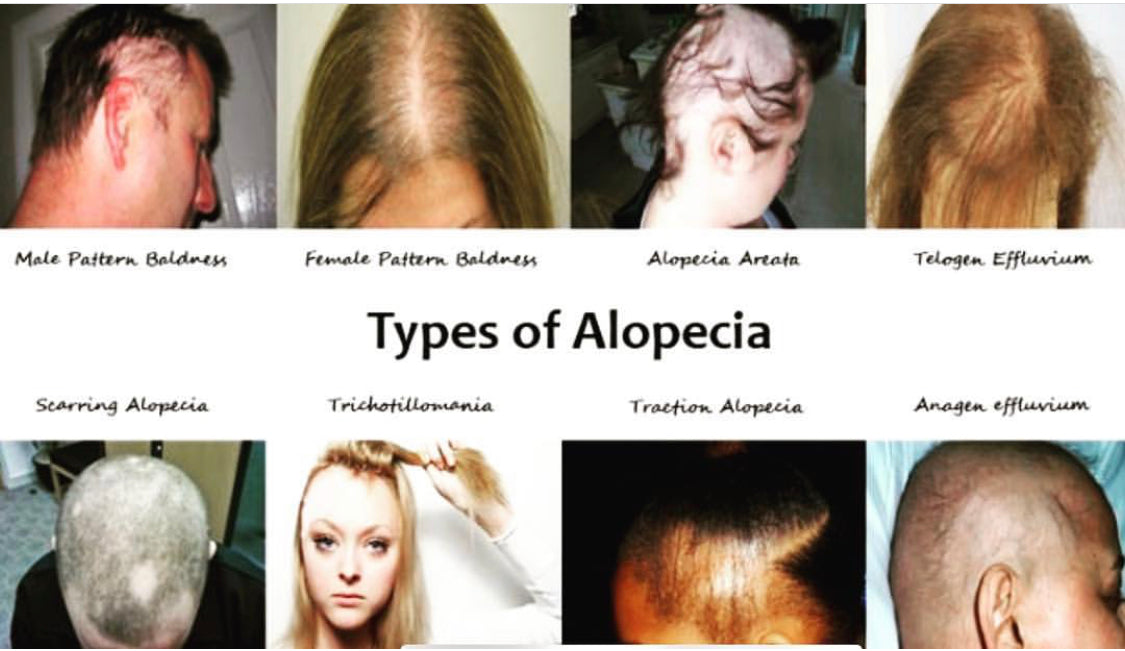The Different Types of Alopecia (Hair Loss)

When we think about hair loss, we often imagine one simple scenario: thinning hair or bald spots. But the reality is much more complex. Alopecia is the medical term for hair loss, and it comes in several different forms—some temporary, some permanent. Understanding these differences is the first step in learning how to treat and manage them.
Nonscarring Alopecia
This type of hair loss does not permanently damage the hair follicle, which means regrowth is often possible.
1. Alopecia Areata
An autoimmune disorder where the body mistakenly attacks hair follicles, leaving behind smooth, round bald patches.
• Patchy Alopecia Areata: Small, round bald spots.
• Alopecia Totalis: Complete loss of hair on the scalp.
• Alopecia Universalis: Loss of all body hair.
Hair may regrow in many cases, but the pattern can be unpredictable.
2. Androgenetic Alopecia (Pattern Baldness)
• In men: Hair typically recedes at the temples and crown.
• In women: Hair thins across the scalp but usually without a receding hairline.
This hereditary type is one of the most common worldwide.
3. Diffuse Patterned vs. Diffuse Unpatterned Alopecia
• DPA: Thinning at the crown and front with some stable hair at the back.
• DUPA: Widespread thinning with no permanent zone of dense hair.
4. Telogen Effluvium
A sudden shedding of hair often caused by stress, illness, medication, or hormonal changes. Luckily, it’s usually temporary once the underlying trigger is resolved.
5. Traction Alopecia
Hair loss caused by repeated pulling from tight hairstyles like braids, ponytails, or extensions. If caught early, hair can regrow.
6. Frictional Alopecia
Loss from constant rubbing (e.g., hats, helmets, or pillow friction). Recovery depends on the extent of follicle stress.
Scarring Alopecia (Cicatricial Alopecia)
Unlike nonscarring forms, scarring alopecia destroys the hair follicle and replaces it with scar tissue. This makes hair loss permanent if untreated.
Types of Scarring Alopecia
• Lichen Planopilaris: Inflammatory patches that can scar over.
• Discoid Lupus Erythematosus: An autoimmune condition causing scaly, scarred scalp lesions.
• Folliculitis Decalvans: Chronic follicle inflammation with pustules and scarring.
• Dissecting Cellulitis of the Scalp: Painful lumps and bumps that eventually scar.
• Frontal Fibrosing Alopecia: Receding hairline and eyebrow loss, common in women after menopause.
• Central Centrifugal Cicatricial Alopecia (CCCA): Begins at the crown and spreads outward, often seen in Black women and sometimes linked to certain styling practices or products.
Why This Matters
Hair loss can take a huge emotional toll. But knowing the type of alopecia you’re dealing with can guide you toward the right solutions—whether it’s lifestyle changes, medical treatments, or protective styling.
⸻
Final Thoughts
If you’re experiencing unusual shedding, bald patches, or scalp irritation, don’t ignore it. Early diagnosis can make all the difference, especially with scarring forms of alopecia. Consult a dermatologist or hair specialist to get to the root cause and start your healing journey.
⸻
References
• National Alopecia Areata Foundation (naaf.org)
• NYU Langone Health – Hair Loss Conditions
• British Association of Dermatologists – Alopecia Resources
• Scarring Alopecia Foundation (scarringalopecia.org)


11 comments
Patricia Jenkins
August 09, 2018 at 07:43 AMScarred alopeica